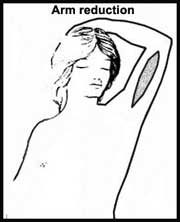In addition to breast reduction and abdominoplasty, other body lifting procedures carried out at our Center include medial thigh lift, posterior body lift and arm lift.
MEDIAL THIGH LIFT
The medial thigh lift is an operation designed to help tighten loose skin in the medial thigh area. It is usually combined with liposuction of this area. An incision is made in the natural crease at the top of the medial thigh. Excess skin is pulled up and removed. The wound is closed by attaching the deep layer of the remaining skin to the ligaments of the groin to provide a longer lasting lift.
The operation does result in a significant amount of discomfort for several days after surgery, but it does help significantly in the reduction of laxity in the area. It also allows more aggressive liposuction in this area that normally requires a very conservative approach to avoid producing skin laxity. While there are scars, they are well hidden in a natural crease and are easily concealed.
ARM REDUCTION
 Concern about large, bulky upper arms has brought many patients to our Center over the years. Some have been discouraged by the need for long incisions required in classical arm reduction techniques. Newer techniques of liposuction have allowed us to successfully treat many of these patients without these incisions.
Concern about large, bulky upper arms has brought many patients to our Center over the years. Some have been discouraged by the need for long incisions required in classical arm reduction techniques. Newer techniques of liposuction have allowed us to successfully treat many of these patients without these incisions.
Patients seeking arm reduction are concerned about excess fat in the upper arms, loose skin, or a combination of both. Traditional arm reduction techniques require incisions down the medial aspect of the arm as shown in the diagram. Effort is made to place the incision in the most hidden portion of the arm, but since the arm is always being rotated, it is impossible to completely hide the scar. While great care is made to close the incision as carefully as possible, using several layers of closure with a final skin layer of fine absorbable suture, thickened or wide scars are still possible.
For a patient with very saggy skin in the upper arms, the resulting scar from surgery is usually a very acceptable trade off, but for patients whose skin is somewhat loose and whose main problem is excess fat, liposuction alone may be an adequate compromise.
With the advent of fine cannula liposuction, combined with the infiltration of a “tumescent” solution of saline (salt water) containing medications to constrict blood vessels and numb the tissues, we can now safely remove moderate amounts of fat in the arms without undue risk of unpleasant side effects. The thin cannulas used today allow us to work immediately beneath the skin, which allows more precise and even fat removal.
Of course there are limitations. Patients with a great deal of skin sag or those with poor skin elasticity may not achieve satisfactory results with liposuction alone and may still require skin excision. Even in these cases, where the two techniques are combined, the results are superior to older types of arm reduction. Combining liposuction with skin removal decreases bleeding and reduces the tension on the wound resulting in better scars.
Both procedures are normally carried out under general anesthesia, although local anesthesia would be an option. Postoperative care consists of the use of an arm wrap for several weeks, but there is no significant limitation on activity. Final results are not apparent for several weeks, and swelling can persist for a few months. When the classic reduction is carried out, it takes many months for the scar to mature.
POSTERIOR BODY LIFT
The posterior body lift is a relatively new addition to the armamentarium of cosmetic surgeons striving to help reverse significant body laxity. The large number of patients undergoing weight loss surgery has stimulated the development of this procedure, although it is certainly not limited to those patients. The posterior body lift is useful for reducing excess skin in the back as well as leading to significant elevation of the buttock and upper thigh.
This operation is often carried out to complement abdominoplasty. In some centers, the two are combined as a circumferential body lift, but since this requires hospitalization, we prefer to stage the procedures allowing the surgery to be carried out on an outpatient basis. Typically, the two procedures are separated by at least six weeks to allow full recovery from the first stage before beginning the second. Either the front or back can be addressed initially.
A long curved incision is made across the back, usually at the level of the upper buttocks. If an abdominoplasty has been accomplished, the incision meets the lateral edge of that incision. Soft tissue of the lower back and upper buttock area is defatted as needed through liposuction, which also helps to release the tissues. The excess is removed and the skin above and below the resected area is advanced and closed with multiple layers of suture, after which the skin is closed with a running layer of fine suture. Usually, drains are not required and recovery is relatively simple, with no special restrictions placed on the patient.
As in all body lifting procedures, it takes time for scars to mature, and although usually quite satisfactory, thickening or widening can occur and may require secondary revision. Other risks, as in all procedures, include bleeding or infection. More and more, patients are requesting this procedure and the results generally are highly satisfactory.

